A Weird and Delicate Thing
Why can’t anyone quite put their finger on what makes this Los Angeles band so special?
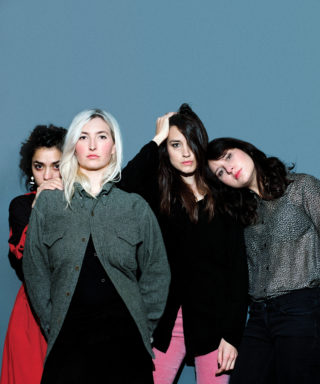
Why can’t anyone quite put their finger on what makes this Los Angeles band so special?
We can only sit and wonder at the unknowable set of circumstances that keep the universe in check. The chains of ecosystems that teeter on the brink; the gentle precarities of hot and cold that keep infinitesimal things alive; the matter of seconds or days or yes/no choices that cause history to tick and that set us down exactly where we are, rather than where we might have been.
While the domestic equivalents of this astronomic balancing act might not be a matter of life or death, there’s still something miraculous in the incidental meeting of minds and the unexpected upshot of a life meandering through places and around people, only to find itself in exactly the right spot. To spend any length of the time in the orbit of Emily Kokal, Theresa Wayman, Jenny Lee-Lindberg and Stella Mozgawa – the four-headed Siren being that is Warpaint – is to witness exactly this kind of joyful equilibrium; a coterie of totally shared understandings and creative intent born out of childhood friendships and deeply forged new ones that happen to fit perfectly.
Kokal and Wayman met at school in Oregon, Lindberg hails from Nevada and Mozgawa from New Zealand, all four of them having drifted separately to LA, a hazy dream-world of possibility in the shape of boys, the amorphous entertainment industry and potential encounters with kindred spirits. Seven years later Warpaint have done the impossible; outliving the idle chatter of their well-worn origin tale – complete with A-list cameos – and making the real story about the rare and curious product of their serendipitous union; an enduring music that feels like it’s always existed – like it was somehow always meant to be.
But like all delicate, harmonious things, Warpaint was a couple of life choices shy of never happening at all…
“I didn’t imagine that I would ever be in an all-girl band,” confesses drummer Mozgawa, “I almost remember saying that to myself. People would say, ‘oh there’s an all-girl band that needs a drummer’ and I’d say nah, that’s not really my thing. My 14yr old self would not have been attracted to it at all.” Similarly for bassist Jenny Lee Lindberg there was a time when being part of a collective was utterly out of the question; “I didn’t start playing music seriously until I was 19 and at that point I hadn’t imagined myself playing in any band. I was so self-conscious and would only practise at certain hours when my boyfriend was gone… I remember telling myself I’m NEVER going to play in front of anybody and I’m never joining a band or playing on stage, the thought of it terrified me!”
With such blatant aversions festering in their individual pasts, it’s incredible that Warpaint find themselves now three years into a definitive line up, a blistering debut album under their belts and – off the back of two years intense touring – another just about to surface.
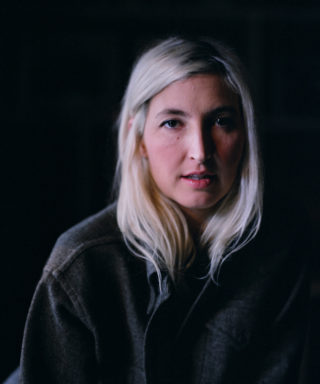
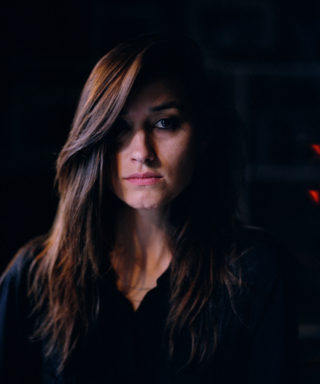
The eponymously titled follow up to 2010’s rapturously received ‘The Fool’ shows no signs of having emerged from a place of fear or doubt; whatever was sparked on the first album has been concentrated, bottled and coolly sprinkled over music that could not really have been made by anyone else. Rather than exhausting them, the relentless tour of those early songs has been galvanising and – with the driving presence of Mozgawa, the last, blistering piece of the puzzle – they’ve cleaned the slate, broken free of familiar patterns and let loose on exploring the wily limits of an even more personal sound. Quite a mountain to scale in the relatively short space of time since Warpaint first started turning heads: “Yeah, we definitely weren’t taking our time and just sitting around,” says Kokal, marvelling at three years vanishing in the blink of an eye.
When we meet they’re a day away from heading home after three months weaving new material into their live set and reliving the process of the new record’s genesis in a string of press interviews. Unsurprisingly they’re flagging a little; occasionally drifting off mid-sentence, fighting to keep awake when the photographer plunges the room into atmospheric darkness for our cover shot and occasionally losing the plot entirely – “wow, I think that was it!” Mozawa gulps, wiping away tears of hysterical laughter and crumbling into incoherency apparently over nothing.
You can’t blame them. Whether it’s because of the unforgettably seductive lure of early tracks like ‘Undertow’, or the tiresome curio nature of an all-female band, or the fact of their starry LA milieu, everyone now wants a piece of Warpaint and will be clamouring to unpick the thorny issue of how you follow a debut as out-of-the-box perfect as ‘The Fool’. Maybe there’s a clue in the title though, an almost self-deprecating allusion to wide eyed beginnings replaced with the possessing embrace of the self-named album, one that speaks most eloquently of who they are at this moment in time, with their particular mark etched into every inch of its being. “It definitely feels more full on this time,” says Wayman of releasing the new record, “but I feel like we’re more conscious of every part of it and we weren’t before. Like, we sat in on the mastering session and we didn’t last time, and I was just sitting there going ‘what?’ how were we not a part of this because it can change everything!”
“I think on this record, more so than any of the others, each of us know where we’re coming from a lot more than we did in the past,” Lindberg adds. “As individuals our visions are clearer and on this record it shows. It also shows that the trust we have for each other is much stronger, so even if an idea doesn’t resonate with you first, let’s hop on that train and see where this goes and that could open up other avenues.”
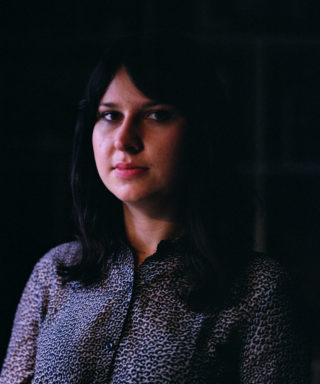
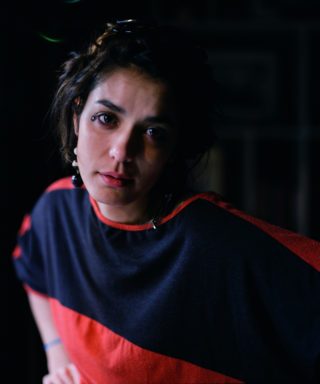
Warpaint’s shared desire for experimentation and the free flowing of individual ideas is the subject on which they’re all most effusive, as if the harmony they’ve clicked into is the perpetual bass note, the only element of their creative process that’s not up for discussion. It’s a mark of maturity, too, and an explanation of the most striking thing about their sound; its unmistakable depth, the unhurried product of something that took its time and is in no doubt about what it is.
As we speak, the silent balance of their group dynamic emerges in a sisterly support, one picking up on another’s dropped thread, full of gentle encouragement to complete a thought and make it to the end of a sentence. In the aftermath of ‘The Fool’, for which each and every idea was thrown at the wall, making mixing and exact live renderings almost impossible, things have developed and fine-tuned into an atmosphere that all four of them can breathe. “We definitely approached writing in a completely different way than we ever have,” Lindberg explains. “It’s not about having one person in charge but it’s getting easier for one person to at least see through and to execute their vision fully, without having any interruptions of, ‘wait here’s my idea, here’s my idea’. The rule right now is: there are four people in this band and we all have something important to say so let’s give each other the respect and the time, and listen.”
“That’s the most liberating, confusing and slow paced thing about the band,” adds Mozgawa, “no one person is holding the flag and saying, ‘that’s a great idea but ultimately I’m judge, jury and executioner’. It’s crazy and impractical sometimes but also it’s where the unique flavour of the band comes from. If you refine it too much you might lose a bit of the muse or something…”
Kokal speaks too of their desire to break out of the tour imposed routine and to shake things up within the band’s infrastructure – for ‘Warpaint’, songs came from all four corners, instruments were swapped and personalities hung back rather than clamouring for some fixed place in the line-up. To any peripheral ear things were working just great, why fix something that isn’t broken? But the four are wise enough to notice that those arbitrary rigours are exactly the kind of thing that can bust a band apart. “I think there’s probably a lot of bands that find a formula that works for them but then there’s that person in the band like George Harrison who never got enough songs on the album because there was something else that was working, or there was competition,” says Kokal. “With our band, at the end of the day, I think fairness plays more of a hand than is normal.”
“And no one is saying, ‘Well I’m not playing on that,’” says Lindberg of individually proposed songs, “none of that bullshit was going on. Not that anyone would have done that in the past, but those feelings would have come up for sure.”
Kicking old habits also means getting out of town and ‘Warpaint’ could quite easily carry the sub-title ‘Escape from LA’; sonically legging it as far as possible from the torpor of sticky, indistinguishable studio time and heading for the rangy wilderness of Joshua Tree, an area of natural beauty on the edge of the Mojave Desert. They rented a house, complete with Geodesic Dome, and set up every instrument they owned on the living room floor. “It’s really easy to go into a practise space for just a little bit and then go back to your life,” says Kokal, “whereas living in this house together, it was all very concentrated on making the album and I think that gave it a depth. The depth of that experience is in the album.”
It’s not hard to image why an expansive landscape, blanketed with starry skies would be a preferable, energising force; not to mention the ease with which you can draw a line between the organic, almost feral edge to their sound and a generative proximity to nature. “I just heard this interesting fact the other day,” confirms Wayman, “when you look at something natural it actually releases endorphins in your brain. Even if it’s something harsh like a rock or a Joshua Tree that’s really spiny, it’s nature so it actually feels good.”
That definition of harsh, invigorating beauty – of a satisfying, night-timey darkness – is more or less the perfect way to describe the twelve tracks on the new record. On first listen it’s a pervasive atmosphere or attitude that strikes you, rather than definable melodies or memorable lyrics. I put this to the band, guessing it to have been their intention, but find out how different it feels to them: “The atmosphere was more intentional than on other records,” agrees Kokal, “but I think on past albums there was a kind of film between the music and the listener, it wasn’t quite as immediate…”
“We didn’t want to create a lot of conflicting melodic lines,” adds Wayman, “but at the same time I feel like it’s not ambiguous or free floating, at least not to my ears – I feel like there’s more succinct songs.”
“We put the vocals up, the lyrics up,” continues Kokal “…the song writing is as much of a focal point as the instrumentation, whereas in the past the vocals were almost just another instrument… there’s a lot more of a vocals pressed to the front, it’s a more traditional style of recording than we did last time.”
Clearly there’s something about the listening experience that involves shifting register and inhabiting the band’s particular wavelength. Like ‘The Fool’, ‘Warpaint’ repays a patient and attentive ear – time passes, the music creeps under your skin and suddenly, out of an amorphous, disorienting whole, those succinct melodies gradually begin to emerge.
The first single swims around the bittersweet, rhythmic mantra “Love is to die / Love is to not die / Love is to dance”; ‘Hi’ broods over crisp electronic beats; ‘Go In’, penned by Mozgawa, is a louche masterpiece of understatement and ‘CC’, driven by Lindberg, might be the grungiest thing they’ll ever produce. The more you delve into the record, the more their specific personalities are revealed, but the thing that tethers it together is the particular blend of timbres that somehow make one, stunning vocal entity; a soft, communal roar that is unmistakably theirs.
“Before the record was finished,” says Lindberg, “we thought the songs were all so different and the record was going to be so eclectic, like no song sounds the same – but I think we surprised ourselves, when you tie them all together, how fluid the record was and how concise it feels.” That cohesion could, in part, be attributed to the involvement of legendary producer Flood whom, along with the expansive desert, Wayman cites as the sixth member of the band. “We’ve ended up with an album that we couldn’t achieve on our own sonically,” she relates. “He has so much experience creating really good sounds, and mic-ing drums in such an incredible way, and being creative with how to layer sonic ideas within a song. All of that is so natural to him that it’s actually pretty hard to know exactly what he’s doing, it seems like nothing’s happening but he’s doing so much!”
Flood’s name is generally mentioned in the same breath as the words seminal and landmark – PJ Harvey, Nick Cave, New Order and U2 all being counted in the roster of his long-term collaborators. But rather than exerting any heavy pressure, his presence simply adds to the band’s status as serious, canny musicians, bristling to explore the boundaries of their sound and continuing to gather people around them that compliment rather than upset the balance of their particular universe. “He’s a real collaborator,” says Kokal, “from the get go, he said ‘you pick what’s comfortable for you’, and that’s pretty amazing for someone of his level. He lived on the premises of the studio, ate what we ate, slept in these little quarters… a really simple, really modest person who was just there to serve the music and to bring out, what he felt, was the best in a circumstance that could be quite stressful.”
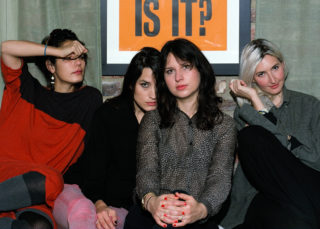
Perhaps the most logical way to translate this atmosphere of closeness that Warpaint both generate and seem to crave creatively is into the notion of a family. And it’s a motley extended one that includes Wayman’s son, her long distance partner James Blake, and Lindberg’s husband – the maverick, Reading born, video director Chris Cunningham – who plays a direct part in bringing the band’s vision for ‘Warpaint’ to life.
For music that sounded so cohesive, the aesthetic that accompanied ‘The Fool’ was arguably pretty jumbled; “everything was scattered,” says Wayman, “it didn’t seem like we knew what we were all about as much as we wanted to portray. So that was a conscious decision this time around, and then we ended up having Chris Cunningham helping us do that!”
The band had begun filming one another during the Joshua Tree sessions, just to document their time and “have something in 40 years, y’know,” as Lindberg puts it. But Cunningham was on site too, working on his own projects and taking his place at the family table before eventually beginning to gather footage of the band himself. The result is Love is to Die, a full length film that will accompany the album when it’s released early next year, but don’t expect a fly on the wall documentary – teaser clips suggest that the potent atmosphere of their creative coven has been distilled, layered and set against an underscore of howling desert winds that are tinged with the ghost-girl harmonies.
Family ties aside, the collaboration makes total sense when you consider the twisted beauty of their oeuvre alongside Cunningham’s own genius for visualising the most shadowy corners of the collective unconscious. With a shared experience of the places they’ve been and a deep sense of the music they’re engaged with making, it’s fair to say that his treatment of Warpaint’s particular brand of noir is likely to be a gentler assault on the senses than his genre (and peaceful sleep) destroying work for Aphex Twin. “Definitely,” says Lindberg. “The record cover he made for us is really timeless, really classic, really beautiful and soft, but with just a hint of edge and darkness. People think he’s the dark lord of music videos but he’s actually a practical joker and really funny!”
“I feel like he’s more mischievous than he is dark,” adds Mozgawa. “I remember seeing ‘Come to Daddy’ and laughing my tits off. Even ‘Windowlicker’, people are like ‘ewwww that’s disgusting’ but I think that’s the funniest shit ever!”
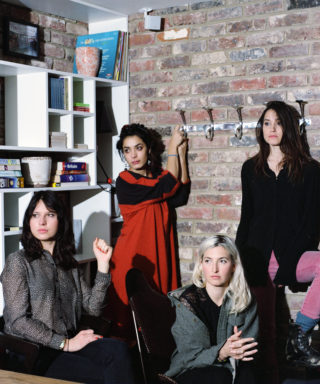
So Cunningham will cast his subtly dark web over everything that emerges under the banner of ‘Warpaint’ – even remixing some of the music – and this time around there’ll be no confusion about what the band want to say about who they are. “We’re so lucky that we have someone that has such an interesting, creative and twisted mind in our inner circle,” enthuses Wayman, “and also that he’s so good at what he does…”
“His soundtrack is probably going to sell more albums than ours!” jokes Kokal.
<drop Cap?>
While they’re clearly focused on driving more of themselves into their music, even opening their private, collective world to a bigger audience in the shape of a film, what makes Warpaint such an alluring prospect is the sense that you can never quite pin them down. Between the music that takes its time, a maturity that defies flighty commercialism and the secret alchemy of their friendship bond, the mercurial nature of the band slides in and out of tangibility; even Cunningham’s album artwork alludes to this – depicting four spectral personalities merging into one chimeric whole. They’re both the strange girls on the peripheries of the schoolyard and a classic girl gang that you’d sell your soul to join. They’re goofballs too, cracking each other up as often as they slip into contemplation; just like the track listing of the new record which flits from the gentle, harmonic tug of ‘Teese’ into ‘Disco/Very’ – the Warpaint-ian notion of a floor filler being a snarling, Slits-y, comic book anthem that carries the warning “Don’t you battle / We’ll kill you / Rip you up and tear you in two”.
“I think we’re all of those things,” muses Mozgawa, “we’re sunny, we’re very emotional and sensitive, and I think being outwardly sunny is sometimes the end of a journey of being tortured and intense and self-aware. As a collective we come to those places where when we’re having fun we’re genuinely having fun and when we’re sad we’re really sad. Being in a band and being encouraged to let those emotions show, both personally and collectively, I think that you get a bit of everything.”
So what’s next for them? While the world casts judgement on the sonic twists and turns of the new album, what will Warpaint do with their renewed sense of balance and possibility? Despite the particularity of their identity as a collective, Mozgawa, Lindberg, Wayman and Kokal are clearly never going to be interested in JUST being instrumentalists and will doubtlessly want to explore projects beyond the limits of the band.
“Being in a band with less people sounds nice,” says Lindberg, “with just one other person y’know… doing something heavy metal! I’ve always wanted to be in an instrumental band too…”
“Yeah, Jen and I have talked about starting a funny project that’s really hard-core,” says Mozgawa, “and I think all of us are totally not intimidated about anyone exploring all the things they want to explore, because it only enhances the experience of being around each other. There’s no antagonism and no one feels held back. I’ve been in situations where I’ve been dissuaded from playing with other people and I feel really lucky that we’re all supportive enough of each other that we can all go off and do our own thing. Aside from the fact that we’re a functioning collective we’re also really hyper and we all have a lot that we want to do while we can.”
Despite having conjured the anxieties of her 19 year old self, it’s Lindberg who articulates the one thing that’s underpinning the whole operation, the thing that keeps the planets aligned and the ship afloat; “It feels special and unique,” she enthuses. “If we broke up or did something else, I feel like it would be missed. It would be something we eventually would want to come back to because, y’know, you can’t really find that anywhere else.”
“Yeah,” says Mozgawa, “It’s a weird delicate thing for sure.”